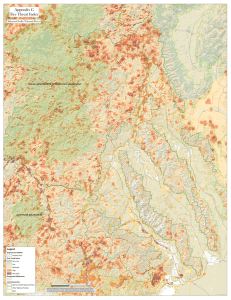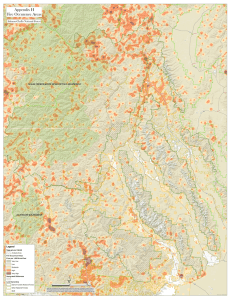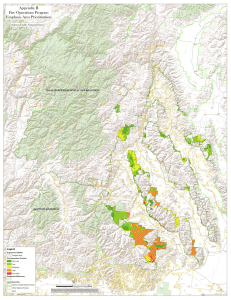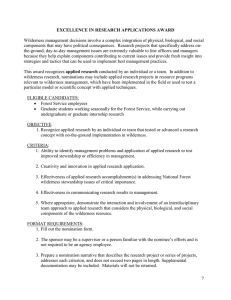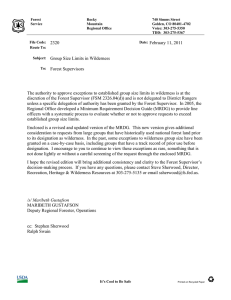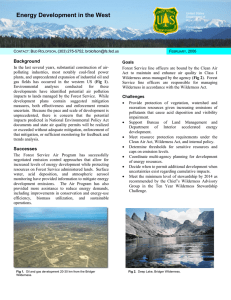Lye Brook By Year
advertisement
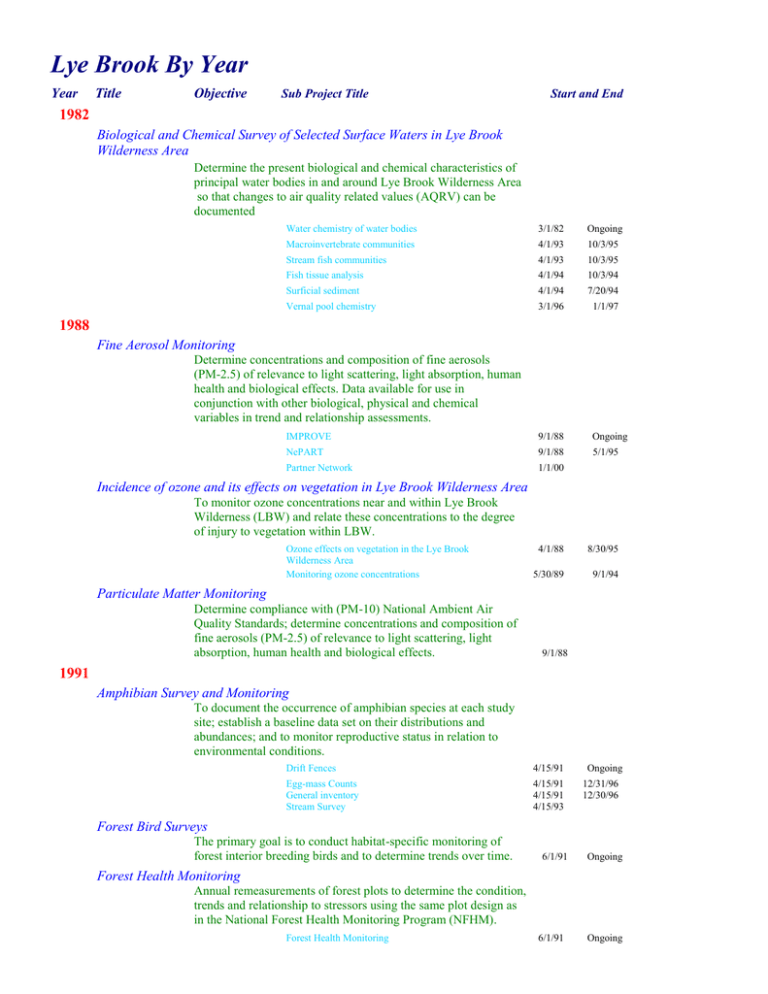
Lye Brook By Year Year Title Objective Sub Project Title Start and End 1982 Biological and Chemical Survey of Selected Surface Waters in Lye Brook Wilderness Area Determine the present biological and chemical characteristics of principal water bodies in and around Lye Brook Wilderness Area so that changes to air quality related values (AQRV) can be documented Water chemistry of water bodies 3/1/82 Ongoing Macroinvertebrate communities 4/1/93 10/3/95 Stream fish communities 4/1/93 10/3/95 Fish tissue analysis 4/1/94 10/3/94 Surficial sediment 4/1/94 7/20/94 Vernal pool chemistry 3/1/96 1/1/97 IMPROVE 9/1/88 Ongoing NePART 9/1/88 5/1/95 Partner Network 1/1/00 1988 Fine Aerosol Monitoring Determine concentrations and composition of fine aerosols (PM-2.5) of relevance to light scattering, light absorption, human health and biological effects. Data available for use in conjunction with other biological, physical and chemical variables in trend and relationship assessments. Incidence of ozone and its effects on vegetation in Lye Brook Wilderness Area To monitor ozone concentrations near and within Lye Brook Wilderness (LBW) and relate these concentrations to the degree of injury to vegetation within LBW. Ozone effects on vegetation in the Lye Brook Wilderness Area Monitoring ozone concentrations 4/1/88 8/30/95 5/30/89 9/1/94 Particulate Matter Monitoring Determine compliance with (PM-10) National Ambient Air Quality Standards; determine concentrations and composition of fine aerosols (PM-2.5) of relevance to light scattering, light absorption, human health and biological effects. 9/1/88 1991 Amphibian Survey and Monitoring To document the occurrence of amphibian species at each study site; establish a baseline data set on their distributions and abundances; and to monitor reproductive status in relation to environmental conditions. Drift Fences 4/15/91 Egg-mass Counts General inventory Stream Survey 4/15/91 4/15/91 4/15/93 Ongoing 12/31/96 12/30/96 Forest Bird Surveys The primary goal is to conduct habitat-specific monitoring of forest interior breeding birds and to determine trends over time. 6/1/91 Ongoing Forest Health Monitoring Annual remeasurements of forest plots to determine the condition, trends and relationship to stressors using the same plot design as in the National Forest Health Monitoring Program (NFHM). Forest Health Monitoring 6/1/91 Ongoing Forest Pest Monitoring Monitoring trends in major insect pest populations, and documenting the occurrence of damage to forests. Forest Damage Survey 6/1/91 Ongoing Ozone Bioindicator Plant Monitoring Detect ozone injury on sensitive native plants, record first occurrence data for each species, and evaluate the maximum severity of the damage. 6/1/91 Tree Phenology Monitoring Annual measurements of tree phenology to establish the timing of developmental events and trends, especially as they relate to changes in weather or insect and disease occurrence. Fall color and leaf drop 7/15/91 1993 Lichens and air quality in the Lye Brook Wilderness Area Collect lichens for a lichen species list; collect lichens for elemental analysis; study the health and distributions of species most sensitive to air pollution; and assess the effects of air quality 7/1/93 8/30/93 2/26/93 12/31/95 Lye Brook Area Ecological Land Type Classification To classify ecological communities in the Lye Brook Area based on an integration of soils, vegetation & physiographic data, that will lead to mapping of these units within the area. 1994 Clean Air Status and Trend Network (CASTNet) To provide site specific data meteorology, dry deposition of sulfur and nitrogen species, wet deposition of major ions, and ozone. To provide air quality data specific to the Lye Brook Wilderness Area, a Class I Wilderness Area, to support research on the effects of air pollution on the Air Quality Related Values (AQRV) of the wilderness area. Meteorology 1/1/94 5/1/2007 Ozone Monitoring 1/1/94 3/31/2007 Dry Deposition 4/6/94 5/1/2007 Wet Deposition 7/4/95 5/1/2007 Effects of acidic deposition on terrestrial and aquatic ecosystems of Class I Wilderness Areas. Determine the distribution of areas sensitive to deposition of sulfur and nitrogen; determine the current status of sensitive areas utilizing atmospheric deposition of nitrogen; determine the degree of base cation leaching and aluminum mobilization (use soil, vegetation, land use history assocations to identify impacts); verify deposition thresholds; and assess impacts to terrestrial and aquatic ecosystems if under the PSD process. 5/1/94 10/18/96 Ozone Bioindicator Plant Monitoring Detect ozone injury on sensitive native plants and evaluate the amount and severity of foliage injury. 6/1/91 High Elevation Pond Sensitive Species Survey Ten year sampling intervals 1/1/1994 Ongoing 1995 Lye Brook - Wildlife Quantify wildlife habitat type and extent. 1/1/95 12/31/95 Year Title Objective Sub Project Title Start and End 1999 Long-term soil monitoring Detect changes in soils due to human caused impacts (i.e. climate change, air pollution, forest management) at two forested sites in Vermont Feasibility study for long term soil monitoring 10/1/99 Ongoing Paleostratigraphy of mercury in lakes and ponds Assess mercury and methyl mercury in sediment cores from lakes and ponds in and around Lye Brook Wilderness Area. Paleostratigraphy of mercury in Branch Pond 6/1/99 12/31/99 2000 Development of Soil Climate Analysis Network (SCAN) sites 9/13/00 Ongoing 7/1/00 10/31/00 Tree nutrition status on long-term soil monitoring plots To determine the content of major elemental nutrients in tree foliage, twigs and wood for use in initial characterization of the long-term soil monitoring sites, and for application in the New England Governors/Eastern Canadian Premiers Forest Sensitivity Mapping Project. 2001 National Visitor Monitoring Annual collection of visitor trends, including numbers and dates 1/1/2001 Ongoing 2002 Biomolecular Indicators of Acid Stress Investigate the effects of air quality, especially acid deposition, on terrestrial and aquatic ecosystems. Specific objectives include assessingn the diversity and community structure of soil bacteria (nitrifiers and methanotrophs) in different acid depostion environments; develop a biomolecular method for determining ecosystem acid stress; and validate the PnET-BGC forest-soil-water model on field, GIS and remote sensing data then regionally apply the model. 6/10/02 2004 Campsite Monitoring Five year sampling intervals 1/1/2004 2005 Stream sampling 1/1/2005 2007 Throughfall Study 1/1/2007 2009 Long Term Wilderness Management Challenge Monitoring Ten year sampling intervals to manage for wilderness characteristics such as primeval experience, solitude, etc. Includes an Air Quality plan for camping. 1/1/2009 6/11/02 2013 Fish Stocking Monitoring Lichen Survey 1/1/2013 Lichens surveyed by Forest Service subcontractors 8/1/2013 2014 Recreation Effects at Bourne Pond Fishing survey 1/1/2004 Start year unknown Aerial Surveys for Insects and Disease (same as Forest Pest Monitoring above?) Aerial surveys in the Green Mountain National Forest for insect pest and disease conditions as a joint effort between the Northeastern Area State and Private Forestry and the Vermont Department of Forests, Parks and Recreation Forest Health Plots Ongoing (FIA?) Ongoing Impaired Stream Monitoring Monitoring of acid precipitation impaired streams outside of the Lye Brook Wilderness area: Bourne Pond Brook and Lye Brook as part of TMDL regulation. Five year sampling due limited funding. Pond Core Monitoring Examine diatom and chrysophyte communities as part of TMDL assessment. Goal is for alkalinity of 2.5 Non-native Plant Survey 1/1/2001?

